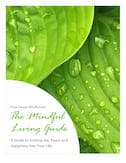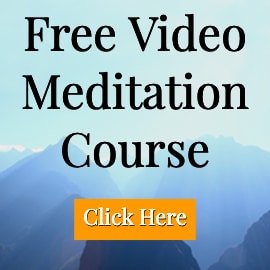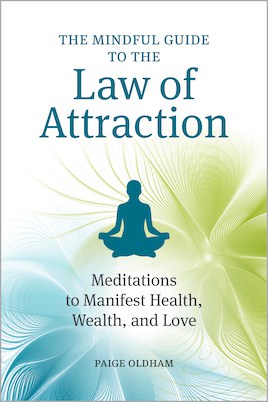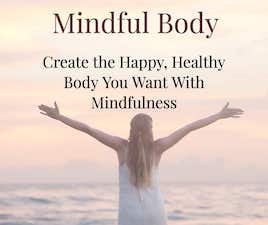Starting a new meditation practice can be difficult. With all the information, apps, gadgets and books out there on the topic, it can feel like information overload. And all that information is probably keeping you from starting a practice that can help you manage all that overload.
I’ve put together a quick resource guide with some basics to get you started without getting overwhelmed. We’re not going to get into specific approaches and nuances. That’s simply more overload at this point. You want to know where to start and where you can learn more. And here it is.
What Meditation Is Not
Meditation does not involve sitting in a lotus position and zenning out for an hour (although it could). In fact, you don’t even have to sit down. There are many forms of meditation: walking, eating, cooking, moving. Check out the infographic below for more ideas.
Meditation does not involve completely clearing your mind and keeping in that state. The human brain wasn’t designed to work that way. Most long-time meditators can’t keep a clear mind for more than a minute or two (I know I can’t).
Check out my article: How to Create a Meditation Practice When Your Mind Won’t Stop Spinning
Meditation isn’t something you practice once a week or so and expect benefits. To reap some of the benefits you read about, it’s something that needs to be done almost every day. Small daily doses are much more effective than longer infrequent session.
Meditation isn’t goal- or accomplishment-oriented. The goal isn’t to clear your mind or be relaxed. It’s all about the process and the practice. Every time you meditate, it’s about noticing when your mind wanders and bringing it back to the present moment and your chosen point of focus (breath, candle, mantra, etc.). When you practice noticing and refocusing, you’re strengthening your ability to focus which pays dividends everywhere else in your life.
There’s No “Right Way”
There are no right or wrong ways of meditating. It doesn’t matter how or where you sit, whether you have your eyes open or closed, how you’re breathing, whether you’re silent or repeating a mantra or anything else. It’s all about the noticing and refocusing.
It’s up to you find your own “right way” – the way that works for you. Everyone is different. That’s why there are so many forms of meditation: transcendental, mindfulness, kundalini, zazen, guided… Like yoga, someone is dreaming up a new type every day.
Some people like to use apps for reminders, timers and guidance. Others completely avoid technology in their practice.
Experiment with many different methods. Mix and match to put together what works for you. Every so often, change things a bit because you’re always changing.
Get Started
With the abundance of information out there, you can end up procrastinating and never starting your practice. Don’t make it difficult.
To start, you’ll need to make the time. I know, I know. You’re too busy and can’t even find five minutes. Reality alert: you just made the time to read this article and probably a few others. Where did that time come from?
If you need an excuse, call it a form of exercise. You’re exercising your mind. The stronger your mind gets with this exercise, the more effective you’ll be in everything else you do.
Carve out just five minutes to start. Even if you have an established practice, it feels so good to take five minutes outside of the normal times you practice to sit, breathe and be fully present.
In those five minutes, sit down wherever you want, close your eyes, relax your body (especially your face and jaw) and notice your breathing and any sensations in your body. Notice any sounds or smells. Notice the things you normally don’t think about or try to block from your mind.
Notice all this without judgment. Everything simply ‘is’ until you create a story about it. Don’t wish away aches and pains. Get objectively curious about them.
When you start thinking of anything in the past or the future or all your to-do’s (which will take a nanosecond to happen), notice it, don’t judge yourself as ‘bad’ for doing it (you’re human), and come back to the present and whatever you were initially noticing (i.e. your breath).
That’s all there is to it.
Learn More About Meditation
Beyond that very basic introduction to meditation, there’s an endless ocean of ways you can deepen and grow your practice. This article includes information from a variety of experts on how to create your own unique meditation space and start your practice. I contributed a section on how to introduce mindfulness into your daily life.
If guided meditation is your thing, there are audios, videos and many apps available.
If you like variety and need some guidance to get started, for only $5 per month, you can have a meditation video emailed to you every day by going to Daily Meditation.
Simple Habit is an app with a multitude of five to twenty minute guided meditations that you can use throughout your day. Just choose what you’re doing, and there’s a meditation for that. It also includes podcasts and tons of other info on meditation from a variety of teachers.
Another great app is 10% Happier: Meditation for Fidgety Skeptics from Dan Harris. The app includes many of the big names in meditation in informative interviews and guided meditations. There are Q&A sections to answer all your questions.
There are endless books, videos, courses and other resources out there to help you with your meditation practice. The choices can be overwhelming. A course I found particularly helpful for all levels is Master Your Mind from LiveAndDare.com, a site devoted to meditation, where you can find answers to all of your questions about meditation.
The Master Your Mind program introduces you to a variety of meditation principles and techniques over the course of 35 days to start you on a daily habit of meditating.
The first few days only ask you to meditate for 2-3 minutes each day. Anyone can do that. In addition to the actual meditation practice, the program helps you to establish triggers and other supports for your new habit. It also helps you manage the inevitable distractions that will come up.
Throughout the 35 days, you’ll be introduced to a variety of techniques as you grow your practice to 20 minutes each day. Although I’ve been meditating for many years, I learned more about how I can deepen my practice and gain more benefits from it.
There are also online forums and sixty days of email access to the creator of the program. While I would have expected the program to cost a few hundred dollars, it’s less than $100 for lifetime access. That’s a small investment for a lifetime of returns.
To make your practice more comfortable, you can put together your own pillows, blankets, and cushions to sit on or invest in a zafu (cushion) and zabuton (mat) at Samadhi Cushions. The company is in Vermont and has been around for over forty years. They make their own products by hand and ship worldwide.
For a list of other meditation resources on the web, check out “Top 40 Meditation Blogs” (of which I’m one). It’s a great resource to learn about different approaches to the practice. You’re sure to find one that works for you here.
Don’t get overwhelmed. Take it one baby step at a time.
Now sit and breathe.
Visit my Recommended Resources page where I post the latest list of books, programs, and products that I’ve found to be particularly helpful in growing your mindfulness and meditation practices.
Create the life you want: Combine the law of attraction with mindfulness
The law of attraction suggests that our positive or negative thoughts bring about positive or negative experiences. My latest book, The Mindful Guide to Law of Attraction, pairs that belief with the powerful practices of mindfulness. Through intentional breathing, writing, and engaging, you’ll hone a method for manifesting health, wealth, and love―the elements of happiness.
Let the law of attraction work for you by adopting its basic steps of identifying and visualizing the things you desire. Then use 45 practical meditation techniques included in the book to achieve awareness. By concentrating your positive energy on obtaining your wants, you’ll give yourself permission to receive them.
To your happiness! ~Paige

You can find this book at Amazon, Barnes & Noble, Books-A-Million, and Indigo.







 The Mindful Living Guide
The Mindful Living Guide




Hi Paige,
Lovely article and great pointers for any beginner meditator. I’ve been meditating for more than 25 years and it has changed my entire life. Now I teach it and help others experience the benefits of living a more balanced and integrated life. I’ve also compiled a few ‘starter’ tips for someone that wants to build a practice. I’ve listed my top five in this video: https://youtu.be/9aLlLL3jzRE
Thanks for the opportunity to share!
Happy Meditating everyone!
Best,
E
Great article Paige! I totally agree with you that “There is No Right Way” you just need to develop a connection with your mind gradually by practicing it daily. many people leave their practice in mid because they think they are not following the rules right or not getting results but they don’t understand that instead of focusing on the rules or the ways to sit, breath, either close eyes or not and etc. They need to look more into forming a connection with their mind without getting distracted this is actually called meditation in my view.
Love that you make it a point to say that there is no right way. I think people get to hung up on if they are doing it right then get frustrated, stressed or stop all together. Be curious and try out the different styles until you find one that works for you.
This is such a great article! I find that people really don’t know what meditation is and do think you have to sit in a lotus position like you mentioned. When I tell clients I meditate in the bus they can’t believe it! All you need is to get started, and keep going! Thank you for putting this guide together.
Great article i loved it. Now a days yoga and meditation is becoming more powerful than all medicine and treatments.
These are very basic tips. I enjoyed your post about meditative practices. Thanks for sharing.
Thanks for the amazing tips, Paige!
I’ve actually been thinking about this as I’ve been researching, writing and teaching about meditation & mindfulness for quite a while! Your post really gives me the inspiration to try it out!
Best wishes on your spiritual journey!
Thanks so much, Demian! Taking a few minutes to meditate each day, especially when you think you’re too busy for it, is incredibly powerful and healing. Like hitting the reset button on the day. All the best to you!
A really nice article on being more mindfull. It will really help you make the most of your circumstances.
That info graphic is a great resource. I love how you encourage people to experiment and to mix and match practices to find what works best for them. Meditation is far to personal for there to be a one size fits all approach. I encourage the same thing with my students.
Thank you, Gavin! Yes, every person is unique and has their own ways of processing the world. Not only does there need to be flexibility with each person, an individual’s needs change over time. What works for you today may not be what works next week or next year. Constant curiosity and experimentation are key to keeping daily practices fresh.
Hey Paige, excellent article for beginners as well as somewhat experienced meditators. I really liked the simplicity of your explanation and how you reinforced the idea that there is no particular right or wrong way. Even after having meditated for a while, I still somehow find myself getting worried if I am doing it right or when I am unable to let go of excessive thinking.
I think you can also add a more detailed point about the importance of building a regular meditation habit instead of doing it inconsistently sometimes. I really struggle a lot in maintaining a regular habit. It is as if the mind is addicted to thinking and unable to let go of overthinking and worrying! 😀
Keep up the good work, look forward to reading more from you!
Thanks so much Vishal! Yes, a regular practice is incredibly powerful in retraining your mind (just like a gratitude practice – see my article: How to Be Happy When Unhappy Is Your Norm). Creating and maintaining a regular habit results from making a 100% commitment to yourself. There’s no “I’ll do it until…” or “I’ll do it unless…” You simply dedicate yourself to the practice no matter what. The transformative results come in almost imperceptible baby steps over time. Your monkey mind will give you plenty of reasons why you can “do it later” or why you have “better” things to do. Listen to it chatter, remember your commitment to yourself and do your practice. Your regular practice can break the mind’s addictions and allow you to let go of the overthinking and worrying.
Thanks for information great blog.
Hi, Since last 6 months i am doing experiments with breathing and to be watchful to thoughts. As much as i put efforts it got more and more difficult. Once i did it with out efforts i feel deeper experience. But i do not know, doing something with efforts is meditation or be in some state with out effort is meditation.
I’m not sure what you mean by “with efforts” Pavitra, but if you try to make it hard, you’ll end up focusing on the trying and how hard it is instead of reaping the benefits of the practice. The key is to simply allow whatever comes up for you, notice it without judging and allow it to pass. Meditation’s only effort is to gently bring your focus back to your breath or mantra or point of focus when your mind wanders (which it will do very frequently). Then allow it to rest there, without effort. As you experienced, when you practice “without effort,” you can allow the practice to go deeper. Don’t force it. Don’t try to make it be something preconceived. Simply allow it to be whatever comes up, whatever your True Self brings to you without effort.
Hi, Paige. I seem to be on a trip down memory lane with blogs I used to read regularly. So happy to see that you are still at it! I enjoyed this post and one that Sandra Pawula wrote not long ago about beginning a meditation practice. I like having some “get started” articles to share with friends who want to but are hesitant.
Anyway, nice to “see” you again. Hope you are doing well.
Great to see you here Galen! Thanks so much for stopping by! Yes, I’m doing quite well, thanks to my meditation practice! Hope you’re doing well too!
Yes, I am, thanks. After a two year break, I started a little blog about a year ago. Fun to be writing again, but not as engaged in blogworld as I was before. Stop by if you want to take a look. In any case, it was nice to reconnect. All the best, Galen
Yes, I am, thanks. After a two year break, I started a little blog about a year ago. Fun to be writing again, but not as engaged in blog world as I was before. Stop by if you want to take a look. In any case, it was nice to reconnect. All the best, Galen
These are good tips. I see meditation as a great way to bring more peace and balance into life. And like you said no matter how busy you are you can always find a few minutes if you really want to.
Hi Paige, I love it when you said, “If you can breathe, you can meditate”.
I love your infographic. It’s informative and makes a nice visual impact!
Thanks so much Evelyn! I strive for simplicity.
Hello Paige…really enjoyed your wisdom on meditative practices. I’ve tried a number of different techniques until I came across one that works perfectly for me. What I notice most about consistently meditating (and usually it’s 10-15 minutes daily) is the change in my reactions to life. Meditation truly does seem to change us at a cellular level that involves no heavy lifting. I’ve always been a fan of easy!
Thanks for the graphic you shared…it’s so insightful.
Those baby steps really do add up Elle! Unfortunately, this process doesn’t appeal to the desire of so many for ‘quick results.’ You’re not helping yourself by stopping after a couple weeks because you don’t see any results. It’s not about the results, it’s all about the process which is different for everyone.
Such a wonderful post, Paige. Too many people get intimidated by meditation and try to make it too complex. Thank you for clearly explaining meditation simply as a mental health tool, which people can use in whatever way suits them best.
I personally do not like the meditation apps – probably because I started “old school” – but I know many who love them. I’m all for whatever works for that person. Nice infographic!
Thanks Debbie! I started “old school” as well and frequently need the silence of a sitting meditation. But in the midst of a busy day or when I’m finding it difficult to rope in a busy mind, the guided meditations of the apps help me to focus.
As with everything else in life, meditation can be as simple or complex as anyone wants to make it. I prefer simplicity.
Thanks for these basic tips to help people get started on mindfulness meditation. You’ve hit on some very important points here like regularity and awareness versus aiming for a blank mind. When people know what’s truly important in meditation, it’s easier to let go of all the overload of information and focus on the basics.
I love the info graphic cause after all the whole point of sitting in meditation is to bring awareness into all aspects of our life. However, I do find some sort of formal meditation whether it is sitting or tai chi movement makes it far easier to be aware in life too.
I’ve never used a meditation app myself so it’s good to know what’s out there. Thank you!
Thank you Sandra! I keep hearing from more people who are seeing positive changes in other areas of their life after they start meditating. One woman I just spoke with who has had issues with her weight because of stress eating is catching herself in the act, mindfully inquiring into her thoughts and emotions in the moment and making new choices (which helps her health and weight management). It also helps with money management and all the other micro decisions we make all day every day that create our habits and our lives.
It’s amazing how one baby step can create such powerful changes.